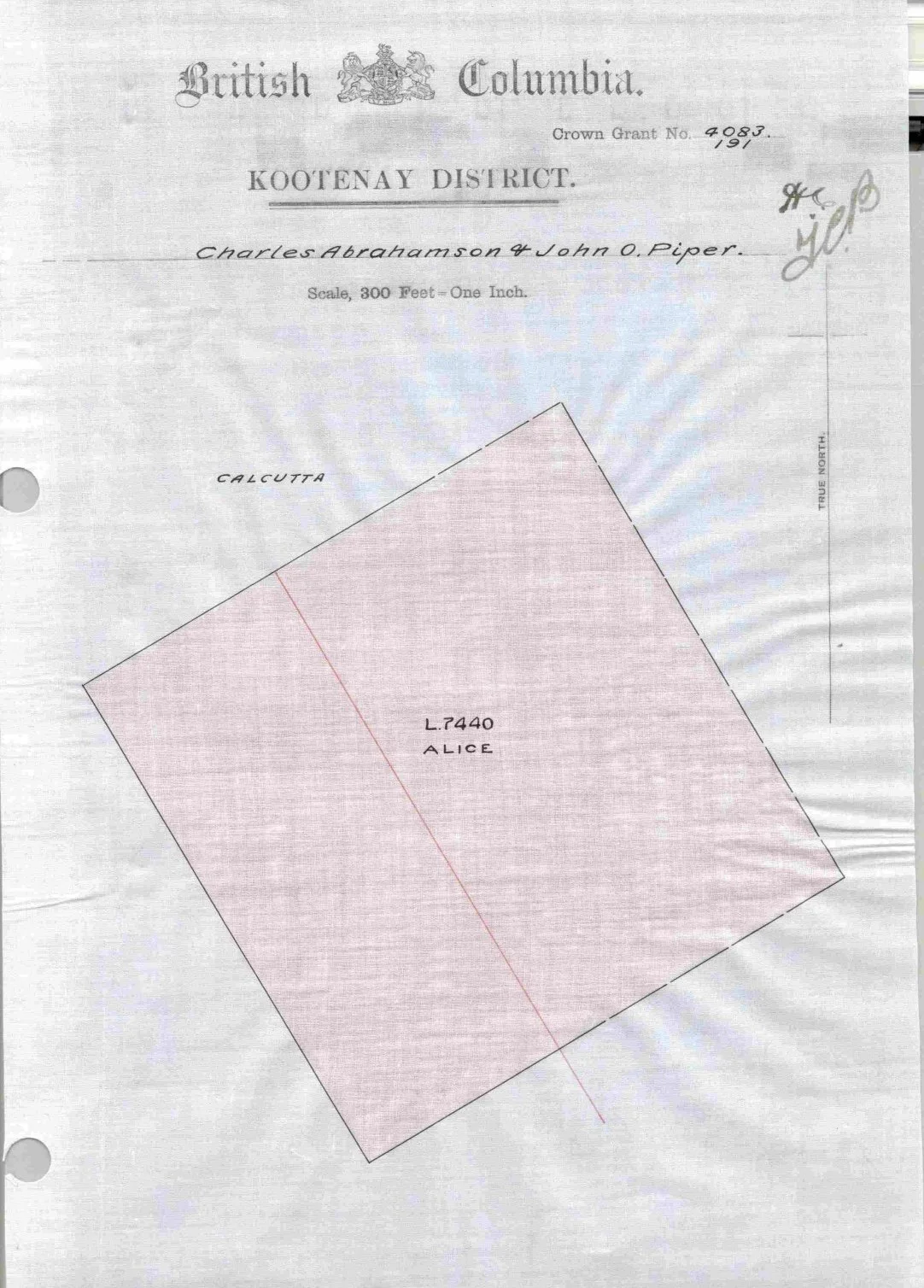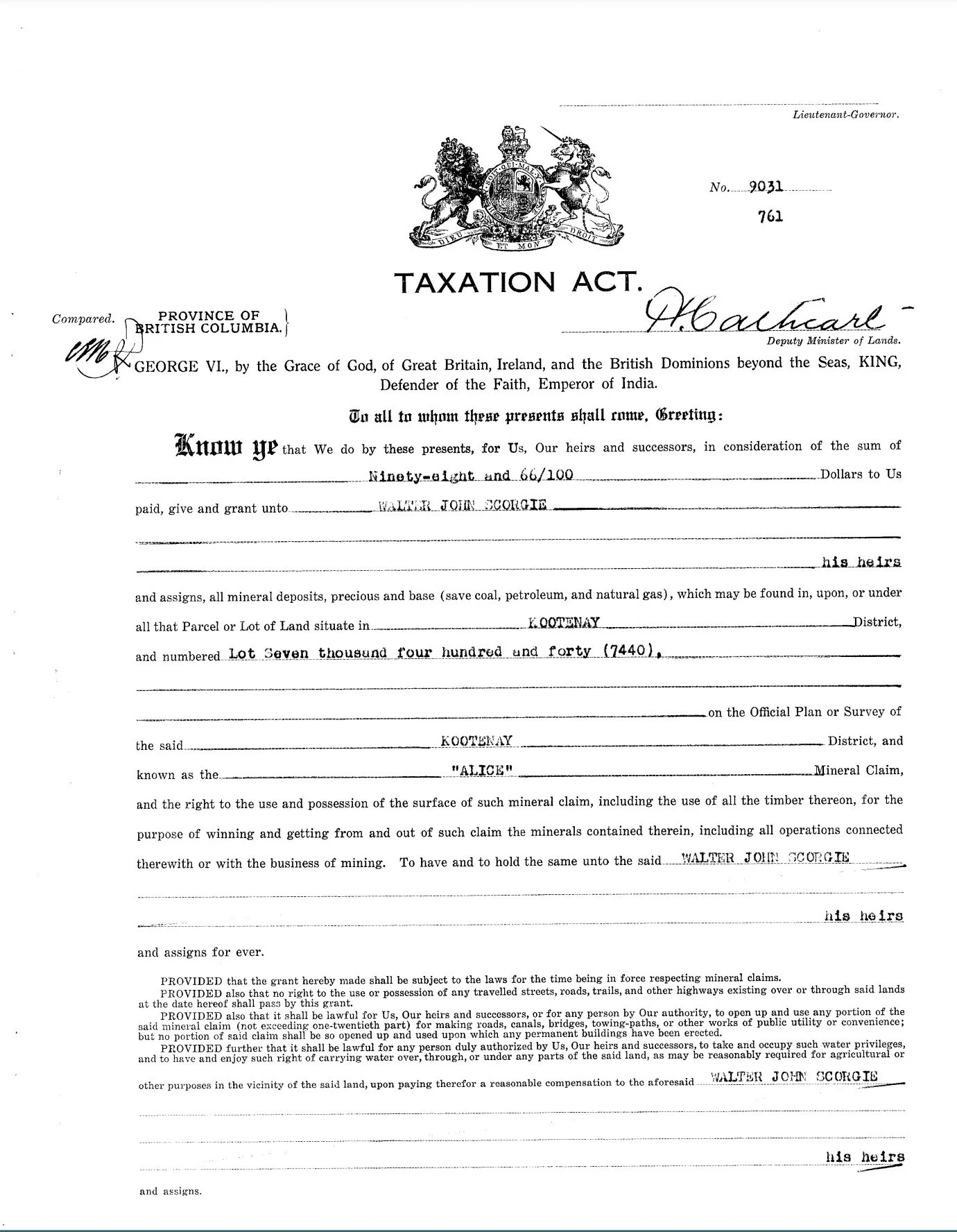ALICE Crown Grant
ALICE Crown Grant
We are selling this crown grant that has surface and timber rights. The property taxes are under 100 a year
This is a crazy rare opportunity to buy one of the few crown grants left
The Alice vein is near the crest of a ridge at 2440 metres elevation. The Alice (L.7440) tenure is at the head of Laughton Creek, which flows to the southwest into Trout Lake. It is also approximately 1.5 kilometres southwest of Triune Mountain.The Alice (Sunshine) vein was originally explored as part of the Foggy Day Group [082KNW117]. It has four adits and several pits. The vein appears to continue onto the Foggy Day [082KNW117] property to the southeast. The No. 1 adit is the eastern-most and lowest of the four exploration adits. It was driven into the cliff-face as a crosscut for 18.3 metres and continued as a drift for 4.6 metres. The No. 2 adit is 15.24 metres to the northwest of the first, and 4.57 metres higher up hill. It was driven as a crosscut for 7.0 metres and as a drift for 7.62 metres. Adit No. 3 is located a further 7.62 metres to the northwest and 1.52 metres upslope. It follows the vein for 10.7 metres. The fourth and uppermost adit, No. 4, is a further 10.7 metres to the northwest and 1.52 metres up hill. It was driven for 3.66 metres. A total of 16.54 tonnes of hand-sorted ore, averaging 124.4 grams per tonne gold, were shipped to the smelter during 1917 and 1918.The Alice claim was part of the Winslow Group in 1950. At that time, the group included the Winslow (L.8680) and Gladhand (L.8681) [082KNW025], Okanagan (L.9127) and Enderby (L.9128) [082KNW024], and the U & I (L.7589) [082KNW023] occurrences. The Alice does not appear to have been part of Winslow Gold's property holding in the 1980s.The Trout Lake area is underlain by a thick succession of sedimentary and volcanic rocks of the Badshot Formation and Lardeau Group near the northern end of the Kootenay arc, an arcuate, north to northwest trending belt of Paleozoic and Mesozoic strata that is now classified as a distinct, pericratonic, terrane. The arc rocks are bordered by Precambrian quartzite in the east and they young to the west, where they are bounded by Jurassic-age intrusive complexes. They were deformed during the Antler orogeny in Devonian-Mississippian time and were refolded and faulted during the Columbian orogeny, in the Middle Jurassic. A large panel, the "Selkirk allochthon", was later offset to the northeast by dip-slip motion along the Columbia River Fault.The Badshot Formation is composed of a thick Cambrian limestone that is a distinctive marker horizon in the Trout Lake area. It is underlain by Hamill Group quartzite and it is overlain by a younger assemblage of limestone, calcareous, graphitic and siliceous argillite and siltstone, sandstone, quartzite and conglomerate, and also mafic volcanic flows, tuffs and breccias, all of which belong to the Lardeau Group. The rocks are isoclinally folded and intensely deformed, but only weakly metamorphosed. They occur as intercalated beds of marble, quartzite and grey, green and black phyllite and schist. Fyles and Eastwood (EMPR BULL 45) subdivided the group into six formations (Index, Triune, Ajax, Sharon Creek, Jowett and Broadview) of which the lowermost (Index) and uppermost (Broadview) are the most widespread. The Triune (siliceous argillite), Ajax (quartzite) and Sharon Creek (siliceous argillite) are restricted to the Trout Lake area. The Jowett is a mafic volcanic unit.The Alice property is largely underlain by black, siliceous, argillite of the Sharon Creek Formation. The rocks stratigraphically overlie Ajax Formation quartzite and they are faulted against a small amount green, gritty metasediment of the Broadview Formation on the southwest side. The rocks are isoclinally folded, deformed and schistose. The foliation strikes to the northwest and dips at a moderate to steep angle to the northeast.The Alice vein is reported to crop out over a strike length of approximately 460 metres on the Alice and Ellen Fraction claims. The vein is well exposed on a cliff face and is visibly discordant to schistocity. It strikes 007 degrees but has a variable dip as it has been affected by a roll in the host phyllite. The dip angles range from 0 to 43 degrees east, average 15 degrees east and increase down dip. The vein is between 0.61 and 1.52 metres wide. It contains a variable amount of pyrite, which appears to contain the gold. The vein is heavily oxidized and leached on surface.It has been explored by four adits and several pits and appears to continue onto the Foggy Day [082KNW117] property to the southeast. Where stopped, the vein in the No. 1 adit was 0.46 metre wide and later showed "only modest" values (1.71 grams per tonne gold and 48.0 grams per tonne silver). In the No. 2 adit the vein is wider, 0.61 to 0.76 metre and better mineralized. Four samples collected in 1946 assayed between a low of 17.1 grams per tonne gold and 39.4 grams per tonne silver over 0.61 metre and a high of 39.1 grams per tonne gold and 116.6 grams per tonne silver over 0.76 metre. In adit No. 3, the vein is between 0.36 and 0.62 metre wide and dips at 12 degrees to the east. One of two samples collected in 1946 assayed 52.8 grams per tonne gold and 89.1 grams per tonne silver over 0.58 metre. The fourth adit, No. 4, cut a quartz vein 0.20 metre wide that assayed 13.71 grams per tonne gold and 13.71 grams per tonne silver. A bulk sample of 16.54 tonnes of hand-sorted ore shipped to the smelter in 1917 and 1918 averaged 124.4 grams per tonne gold.
https://minfile.gov.bc.ca/Summary.aspx?minfilno=082KNW165
This is a land title

